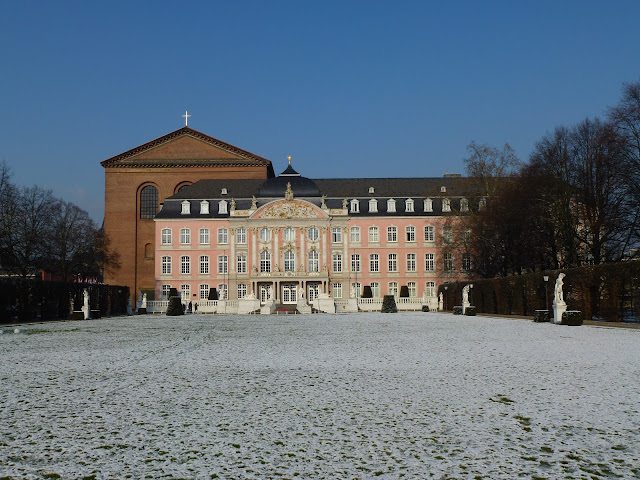Todays lesson is `when in Germany do as the Germans do`. Now I know why they all put on a scarf and wear gloves, because it's darn bitter outside (bloody cold).
An earlier start today, well 10:00 which is early on holidays, as there was a 205km trip road to Trier. About 60km out of Leverkusen we came across the first snow which was not expected but welcome as I didn't believe winter had come to Europe.
Trier is Germany's oldest city and contains the best preserved Roman ruins and has 8 UNESCO declared world heritage sites and once was the seat of Roman emperors. It contains buildings surpased in size and magnificence only by Rome. Based in the Mosel valley it is also a premier wine growing region.
First stop on arrival was for coffee opposite the Porta Nigra city gate or `Black Gate` which is the largest surviving Roman gate worldwide. The name dates from 1060 when the gate was turned into a double church, St Simeon, and named after the Greek hermit who lived walled up inside (1028 - 1035)
Porta Nigra and interior views
The top storey of the gate provides magnificent views over the surrounding country side and city of Trier.
Next Brigitte and Andreas bought a city map so that we had some sort of plan as to what to see because everything is interesting, beautiful or old and the time was limited to a couple of hours. However the next stop was a to buy a warm scarf.
Wow that's nice and warm
The city centres of Trier has many wonderous places of interest:
The medieval market and cross from 958AD
Traffic in the city centre is very light due to small modern cars.
There were also some famouse people who come from Trier such as Karl Marx and Constantine the first Holy Roman emperor who spend much time here and was responsible for building the Roman throne hall, the Constantine Basillica in 310AD, which is still in use today after 1300 years as a church.
Constantine Basillica 310AD
There was also a visit to the Roman bridge but at the end of the day all bridges look the same so I wont show you any photos. After the basillica there is a beautiful view of the Electoral palace which is attached to the back of the basillica.But wait there is more to see before going home, the Frauenkirche (Church of our Lady) and the Cathedral.
Frauenkirche (Church of our Lady)
Computer writing the bible with a fountain pen
St Peters Cathedral from 336AD
St Peters was build during the time of Constantine in 336AD, raised by the Vikings and then rebuild, the roof later collapsed during and earthquake but was rebuild and over the centuries added to to. Within some of the collumns are still sections of the Roman temple of Saturn and statues. This building is also listed by UNESCO.
And to finish a long day I went to English classes with Andreas.


.JPG)















No comments:
Post a Comment